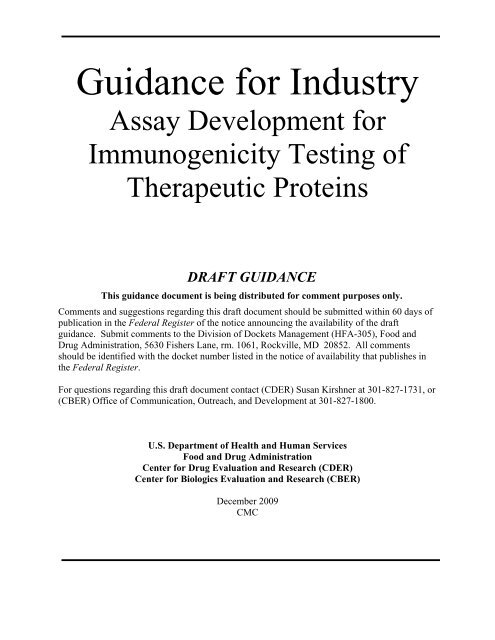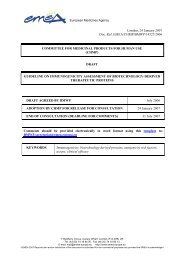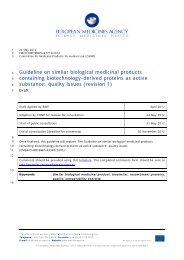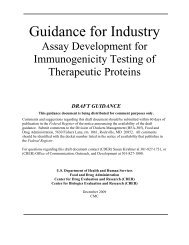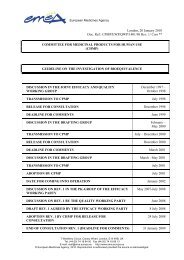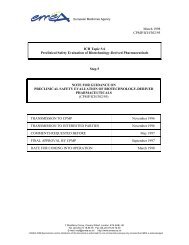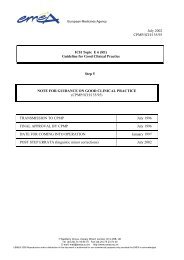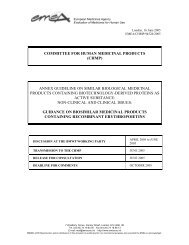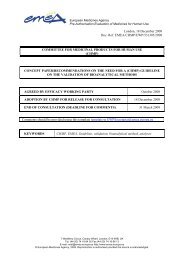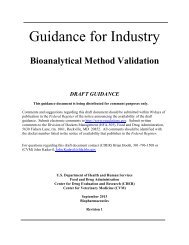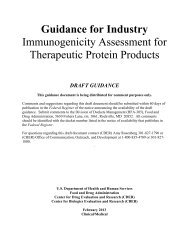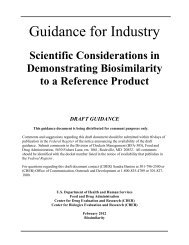Guidance for Industry - Assay Development
Assay Development for Immunogenicity Testing of Therapeutic Proteins, Draft Guidance http://www.ipm-biotech.de/fileadmin/user_upload/pdf/guidelines/FDA-GUIDANCE-Assay-Development-Immunogenicity-Testing.pdf
Assay Development for Immunogenicity Testing of Therapeutic Proteins, Draft Guidance
http://www.ipm-biotech.de/fileadmin/user_upload/pdf/guidelines/FDA-GUIDANCE-Assay-Development-Immunogenicity-Testing.pdf
Create successful ePaper yourself
Turn your PDF publications into a flip-book with our unique Google optimized e-Paper software.
<strong>Guidance</strong> <strong>for</strong> <strong>Industry</strong><br />
<strong>Assay</strong> <strong>Development</strong> <strong>for</strong><br />
Immunogenicity Testing of<br />
Therapeutic Proteins<br />
DRAFT GUIDANCE<br />
This guidance document is being distributed <strong>for</strong> comment purposes only.<br />
Comments and suggestions regarding this draft document should be submitted within 60 days of<br />
publication in the Federal Register of the notice announcing the availability of the draft<br />
guidance. Submit comments to the Division of Dockets Management (HFA-305), Food and<br />
Drug Administration, 5630 Fishers Lane, rm. 1061, Rockville, MD 20852. All comments<br />
should be identified with the docket number listed in the notice of availability that publishes in<br />
the Federal Register.<br />
For questions regarding this draft document contact (CDER) Susan Kirshner at 301-827-1731, or<br />
(CBER) Office of Communication, Outreach, and <strong>Development</strong> at 301-827-1800.<br />
U.S. Department of Health and Human Services<br />
Food and Drug Administration<br />
Center <strong>for</strong> Drug Evaluation and Research (CDER)<br />
Center <strong>for</strong> Biologics Evaluation and Research (CBER)<br />
December 2009<br />
CMC
<strong>Guidance</strong> <strong>for</strong> <strong>Industry</strong><br />
<strong>Assay</strong> <strong>Development</strong> <strong>for</strong><br />
Immunogenicity Testing of<br />
Therapeutic Proteins<br />
Additional copies are available from:<br />
Office of Communication<br />
Division of Drug In<strong>for</strong>mation, WO51, Room 2201<br />
Center <strong>for</strong> Drug Evaluation and Research<br />
Food and Drug Administration<br />
10903 New Hampshire Ave.<br />
Silver Spring, MD 20993<br />
(Tel) 301-796-3400; (Fax) 301-847-8714<br />
druginfo@fda.hhs.gov<br />
http://www.fda.gov/AnimalVeterinary/<strong>Guidance</strong>ComplianceEn<strong>for</strong>cement/<strong>Guidance</strong><strong>for</strong><strong>Industry</strong>/default.htm<br />
Office of Communication, Outreach, and<br />
<strong>Development</strong>, HFM-40<br />
Center <strong>for</strong> Biologics Evaluation and Research<br />
Food and Drug Administration<br />
1401 Rockville Pike, Suite 200N, Rockville, MD 20852-1448<br />
ocod@fda.hhs.gov<br />
http://www.fda.gov/BiologicsBloodVaccines/<strong>Guidance</strong>ComplianceRegulatoryIn<strong>for</strong>mation/<strong>Guidance</strong>s/default.htm<br />
(Tel) 800-835-4709 or 301-827-1800<br />
U.S. Department of Health and Human Services<br />
Food and Drug Administration<br />
Center <strong>for</strong> Drug Evaluation and Research (CDER)<br />
Center <strong>for</strong> Biologics Evaluation and Research (CBER)<br />
December 2009<br />
CMC
Contains Nonbinding Recommendations<br />
Draft — Not <strong>for</strong> Implementation<br />
TABLE OF CONTENTS<br />
I. INTRODUCTION............................................................................................................ . 1<br />
II. DISCUSSION .................................................................................................................... 1<br />
A. General......................................................................................................................................1<br />
B. Immunogenicity Testing During Product <strong>Development</strong>.......................................................2<br />
C. Principles of Immunogenicity Testing During Product <strong>Development</strong> ................................2<br />
III. APPROACH TO ASSAY DEVELOPMENT................................................................ . 3<br />
A. Overview of Design Elements.................................................................................................. 3<br />
1. Multi-tiered Approach.......................................................................................................... .3<br />
2. Aspects of <strong>Assay</strong> <strong>Development</strong> .............................................................................................4<br />
B. Screening <strong>Assay</strong>....................................................................................................................... .4<br />
1. Selection of Format.............................................................................................................. .4<br />
2. Selection of <strong>Assay</strong> and Reagents.......................................................................................... .4<br />
3. Interference and Matrix ........................................................................................................6<br />
4. Defining a Positive Result.................................................................................................... .7<br />
C. Neutralization <strong>Assay</strong>............................................................................................................... .7<br />
1. Selection of Format.............................................................................................................. .7<br />
2. Activity Curve .......................................................................................................................7<br />
3. Interference.......................................................................................................................... .8<br />
4. Confirmation of Neutralizing Antibodies............................................................................. .9<br />
5. Cut Point of Neutralizing Antibodies <strong>Assay</strong>s ........................................................................9<br />
6. Multiple Functional Domains.............................................................................................. .9<br />
IV. CLINICAL ASPECTS OF ASSAY VALIDATION ........................................................... 9<br />
A. Critical Considerations and Caveats.................................................................................... 10<br />
B. Determining the Minimal Dilution .......................................................................................10<br />
1. Importance......................................................................................................................... .10<br />
2. Approach ............................................................................................................................10<br />
3. Recommendation ................................................................................................................10<br />
C. <strong>Assay</strong> Cut Point ......................................................................................................................10<br />
1. Definition........................................................................................................................... .11<br />
2. Determination.................................................................................................................... .11<br />
3. Recommendation ................................................................................................................11<br />
V. ASSAY VALIDATION........................................................................................................ . 11<br />
C:\8495dft.doc<br />
11/4/09<br />
A. Validation of Screening <strong>Assay</strong> ..............................................................................................12<br />
1. Sensitivity ............................................................................................................................12
Contains Nonbinding Recommendations<br />
Draft — Not <strong>for</strong> Implementation<br />
2. Specificity ...........................................................................................................................12<br />
3. Precision............................................................................................................................ .13<br />
4. Robustness and Sample Stability....................................................................................... .13<br />
B. Validation of Neutralizing <strong>Assay</strong> ..........................................................................................14<br />
1. Sensitivity ...........................................................................................................................14<br />
2. Specificity ...........................................................................................................................14<br />
3. Precision............................................................................................................................ .14<br />
4. Other Elements of Neutralizing <strong>Assay</strong> Validation............................................................. .14<br />
C. Validation of Immunodepletion/Competitive Confirmatory <strong>Assay</strong> ..................................15<br />
VI. IMPLEMENTATION OF ASSAY TESTING ................................................................ 15<br />
A. Obtaining Patient Samples.................................................................................................... 15<br />
B. Concurrent Positive and Negative Quality Controls.......................................................... .16<br />
C. Cut Point Normalization .......................................................................................................16<br />
D. Reporting Patient Results..................................................................................................... .17<br />
E. Pre-existing Antibodies......................................................................................................... .17<br />
F. Specific Considerations......................................................................................................... .17<br />
1. Monoclonal Antibodies...................................................................................................... .17<br />
2. Rheumatoid Factor............................................................................................................ .17<br />
3. Fusion Proteins ..................................................................................................................18<br />
4. High Levels of Endogenous Protein in Sera...................................................................... .18<br />
VII. OTHER ASPECTS OF IMMUNOGENICITY TESTING ........................................... 18<br />
A. Isotypes................................................................................................................................... .18<br />
B. Epitope Specificity................................................................................................................. .18<br />
VIII. REFERENCES............................................................................................................... . 19<br />
C:\8495dft.doc<br />
11/4/09
1<br />
2<br />
3<br />
4<br />
5<br />
Contains Nonbinding Recommendations<br />
Draft — Not <strong>for</strong> Implementation<br />
<strong>Guidance</strong> <strong>for</strong> <strong>Industry</strong> 1<br />
<strong>Assay</strong> <strong>Development</strong> <strong>for</strong> Immunogenicity Testing<br />
of Therapeutic Proteins<br />
6 This draft guidance, when finalized, will represent the Food and Drug Administration’s (FDA’s) current<br />
7 thinking on this topic. It does not create or confer any rights <strong>for</strong> or on any person and does not operate to<br />
8 bind FDA or the public. You can use an alternative approach if the approach satisfies the requirements of<br />
9 the applicable statutes and regulations. If you want to discuss an alternative approach, contact the FDA<br />
10<br />
11<br />
staff responsible <strong>for</strong> implementing this guidance. If you cannot identify the appropriate FDA staff, call<br />
the appropriate number listed on the title page of this guidance.<br />
12<br />
13<br />
14<br />
15<br />
16<br />
17<br />
18<br />
19<br />
20<br />
21<br />
22<br />
23<br />
24<br />
25<br />
26<br />
27<br />
28<br />
29<br />
30<br />
31<br />
32<br />
33<br />
34<br />
35<br />
36<br />
37<br />
38<br />
I. INTRODUCTION<br />
This guidance provides recommendations to facilitate industry’s development of immune assays<br />
<strong>for</strong> assessment of the immunogenicity of therapeutic proteins during clinical trials. 2 This<br />
document includes guidance <strong>for</strong> binding assays, neutralizing assays, and confirmatory assays.<br />
While the document does not specifically discuss the development of immune assays <strong>for</strong> animal<br />
studies, the concepts discussed are relevant to the qualification and validation of immune studies<br />
<strong>for</strong> preclinical evaluation of data.<br />
This document does not discuss the product and patient risk factors that may contribute to<br />
immune response rates (immunogenicity).<br />
In addition, this document does not specifically discuss how results obtained from immunoassays<br />
relate to follow-on biologic therapeutic proteins. However, elements of assay validation may<br />
affect comparability determinations of immune responses. FDA guidance documents, including<br />
this guidance, do not establish legally en<strong>for</strong>ceable responsibilities. Instead, guidances describe<br />
the Agency’s current thinking on a topic and should be viewed only as recommendations, unless<br />
specific regulatory or statutory requirements are cited. The use of the word should in Agency<br />
guidances means that something is suggested or recommended, but not required.<br />
II.<br />
DISCUSSION<br />
A. General<br />
1 This guidance has been prepared by the Office Biotechnology Products in the Office of Pharmaceutical Science,<br />
Center <strong>for</strong> Drug Evaluation and Research (CDER) and the Center <strong>for</strong> Biologics Evaluation and Research (CBER) at<br />
the Food and Drug Administration.<br />
2 This guidance does not pertain to immunogenicity assays <strong>for</strong> assessment of immune response to preventative and<br />
therapeutic vaccines <strong>for</strong> infectious disease indications.<br />
C:\8495dft.doc<br />
11/4/09<br />
1
39<br />
40<br />
41<br />
42<br />
43<br />
44<br />
45<br />
46<br />
47<br />
48<br />
49<br />
50<br />
51<br />
52<br />
53<br />
54<br />
55<br />
56<br />
57<br />
58<br />
59<br />
60<br />
61<br />
62<br />
63<br />
64<br />
65<br />
66<br />
67<br />
68<br />
69<br />
70<br />
71<br />
72<br />
73<br />
74<br />
75<br />
76<br />
77<br />
78<br />
79<br />
80<br />
81<br />
82<br />
Contains Nonbinding Recommendations<br />
Draft — Not <strong>for</strong> Implementation<br />
The clinical effect of patient immune responses to therapeutic proteins has ranged from no effect<br />
at all to extreme harmful effects to patient health. The potential <strong>for</strong> such varied immune<br />
responses affect product safety and efficacy. Because this range exists, clinicians rely on the<br />
immunogenicity section of the package labeling that contains immunogenicity rates observed<br />
during clinical trials. This makes the development of valid, sensitive immune assays a key<br />
aspect of product development.<br />
For new products, the design of such assays poses many challenges to applicants and FDA<br />
supports an evolving approach to assay development and validation during product development.<br />
Because these assays are critical when immunogenicity poses a high-risk and real time data<br />
concerning patient responses are needed, the applicant should implement preliminary validated<br />
assays early (preclinical and phase 1). Therapeutic proteins are frequently immunogenic in<br />
animals. Immunogenicity in animal models is not predictive of immunogenicity in humans.<br />
However, assessment of immunogenicity in animals may be useful to interpret nonclinical<br />
toxicology and pharmacology data. In addition, immunogenicity in animal models may reveal<br />
potential antibody related toxicities that could be monitored in clinical trials.<br />
In other situations, FDA recommends the applicant bank patient samples so samples can be<br />
tested when suitable assays are available. FDA expects that the assays will be refined during<br />
product development and the suitability of the assays will be reassessed according to their use.<br />
For example, FDA does not require an applicant to establish interoperator precision early in<br />
clinical development if only a single operator is per<strong>for</strong>ming an assay. Nevertheless, at the time<br />
of license application, the applicant should provide data supporting full validation of the assays.<br />
B. Immunogenicity Testing During Product <strong>Development</strong><br />
Even though different companies developing similar products employ fully validated assays to<br />
assess immunogenicity, such assays will differ in a number of parameters. These differences can<br />
make immunogenicity comparisons across products in the same class invalid. A true comparison<br />
of immunogenicity across different products in the same class can best be obtained by<br />
conducting head-to-head patient trials using a standardized assay that has equivalent sensitivity<br />
and specificity <strong>for</strong> both products. When such trials are not feasible, FDA recommends the<br />
applicant develop assays that are highly optimized <strong>for</strong> sensitivity, specificity, precision, and<br />
robustness.<br />
FDA believes that such assays enable a true understanding of the immunogenicity, safety, and<br />
efficacy of important therapeutic protein products. The detection of antibodies is dependent on<br />
key operating parameters of the assays (e.g., sensitivity, specificity, methodology, sample<br />
handling) which vary between assays. There<strong>for</strong>e, in the product labeling, FDA does not<br />
recommend comparing the incidence of antibody <strong>for</strong>mation between products when different<br />
assays are used.<br />
C. Principles of Immunogenicity Testing During Product <strong>Development</strong><br />
C:\8495dft.doc<br />
11/4/09<br />
2
83<br />
84<br />
85<br />
86<br />
87<br />
88<br />
89<br />
90<br />
91<br />
92<br />
93<br />
94<br />
95<br />
96<br />
97<br />
98<br />
99<br />
100<br />
101<br />
102<br />
103<br />
104<br />
105<br />
106<br />
107<br />
108<br />
109<br />
110<br />
111<br />
112<br />
113<br />
114<br />
115<br />
116<br />
117<br />
118<br />
119<br />
120<br />
121<br />
122<br />
123<br />
124<br />
125<br />
126<br />
127<br />
128<br />
Contains Nonbinding Recommendations<br />
Draft — Not <strong>for</strong> Implementation<br />
Multiple approaches may be appropriate <strong>for</strong> immunogenicity testing during clinical trials.<br />
However, when designing immunogenicity assays and their application to patient testing, the<br />
applicant should address the following:<br />
• Sensitivity. The assays should have sufficient sensitivity to detect clinically relevant<br />
levels of antibodies.<br />
• Interference. <strong>Assay</strong>s results may be affected by interference from the matrix or from onboard<br />
product and this potential effect should be evaluated.<br />
• Functional or physiological consequences. Immune responses may have multiple effects<br />
including neutralizing activity and ability to induce hypersensitivity responses, among<br />
others. Immunogenicity tests should be designed to detect such functional consequences.<br />
• Risk based application. The risk to patients of mounting an immune response to product<br />
will vary with the product.<br />
The applicant should provide a rationale <strong>for</strong> the immunogenicity testing paradigm. Further<br />
recommendations on assay development and validation are provided below. These<br />
recommendations are based on common issues encountered by the Agency upon review of<br />
immunogenicity submissions. In addition, other publications may also be consulted <strong>for</strong><br />
additional insight (see section VIII, 1, 2).<br />
III.<br />
APPROACH TO ASSAY DEVELOPMENT<br />
A. Overview of Design Elements<br />
1. Multi-tiered Approach<br />
Because of the size of some clinical trials and the necessity of testing patient samples at several<br />
time-points, FDA recommends a multi-tiered approach to the testing of patient samples. In this<br />
approach, a rapid, sensitive screening assay should initially be used to assess samples. Samples<br />
testing positive in the screening assay should then be subjected to a confirmatory assay. For<br />
example, a competition assay could confirm that antibody is specifically binding to product and<br />
that the positive finding is not a result of non-specific interactions of the test serum or detection<br />
reagent with other materials in the assay milieu such as plastic or other proteins.<br />
This approach should lead to a culling of samples that should then be tested in other assays, such<br />
as neutralizing assays, that are generally more laborious and time-consuming. Neutralizing<br />
antibodies (NAB) are generally of more concern than binding antibodies (BAB) that are not<br />
neutralizing, but both may have clinical consequences. Further, tests to assess the isotype of the<br />
antibodies and their epitope specificity may also be recommended once samples containing<br />
antibodies are identified by the screening assay.<br />
Although results of patient sample testing are often reported as positive vs. negative, an<br />
assessment of antibody levels is in<strong>for</strong>mative. FDA, there<strong>for</strong>e, recommends that positive<br />
C:\8495dft.doc<br />
11/4/09<br />
3
129<br />
130<br />
131<br />
132<br />
133<br />
134<br />
135<br />
136<br />
137<br />
138<br />
139<br />
140<br />
141<br />
142<br />
143<br />
144<br />
145<br />
146<br />
147<br />
148<br />
149<br />
150<br />
151<br />
152<br />
153<br />
154<br />
155<br />
156<br />
157<br />
158<br />
159<br />
160<br />
161<br />
162<br />
163<br />
164<br />
165<br />
166<br />
167<br />
168<br />
169<br />
170<br />
171<br />
172<br />
173<br />
174<br />
Contains Nonbinding Recommendations<br />
Draft — Not <strong>for</strong> Implementation<br />
antibody responses be reported as a titer (e.g., the reciprocal of the highest dilution that gives a<br />
value equivalent to the cut point of the assay). Values may also be reported as amount of drug<br />
(in mass units) neutralized per volume serum with the caveat that these are arbitrary in vitro<br />
assay units and cannot be used to directly assess drug availability in vivo. Antibody levels<br />
reported in mass units based on interpolation of data from standard curves generated with a<br />
positive control standard antibody are generally less in<strong>for</strong>mative because interpretation is based<br />
on the specific control antibody.<br />
2. Aspects of <strong>Assay</strong> <strong>Development</strong><br />
There are several important concepts to remember when using this multi-tiered approach to<br />
assess immunogenicity. First, the initial screening should be very sensitive. A low, but defined<br />
false positive rate is desirable because it maximizes detection of true positives. Other assays can<br />
be subsequently employed to exclude false positive results when determining the true incidence<br />
of immunogenicity.<br />
Second, the assay should be able to detect all isotypes (particularly immunoglobulin M (IgM)<br />
and the different immunoglobulin G (IgG) isotypes).<br />
Third, FDA recognizes that antibodies generated in patients may have varied avidities <strong>for</strong> the<br />
product, while the positive controls used to validate the assay and demonstrate data legitimacy<br />
may only represent a subset of potential avidities. Although this may be unavoidable, FDA<br />
recommends the applicant carefully consider the avidity of controls used to evaluate the assay.<br />
A fourth consideration is how interference from biological materials (matrix, e.g., serum,<br />
plasma) will affect assay per<strong>for</strong>mance. The applicant should conduct assay per<strong>for</strong>mance tests in<br />
the same concentration of matrix as that used to assess patient samples. The applicant should<br />
also define the dilution factor that will be used <strong>for</strong> preparation of patient samples be<strong>for</strong>e<br />
validation studies assessing potential interference of matrix on assay results.<br />
B. Screening <strong>Assay</strong><br />
1. Selection of Format<br />
A number of different <strong>for</strong>mats are available <strong>for</strong> screening assays. These include, but are not<br />
limited to, direct binding enzyme-linked immuno sorbent assay (ELISA), bridging ELISA,<br />
radioimmunoprecipitation assays (RIPA), surface plasmon resonance (SPR), Bethesda <strong>Assay</strong><br />
(<strong>for</strong> clotting factor inhibitors, see section VIII, 3), and bridging electrochemiluminescence<br />
assays. Each assay has its advantages and disadvantages as far as rapidity of throughput,<br />
sensitivity, and availability of reagents. One of the major differences between each of these<br />
assays is the number and vigor of washes, which can have an effect on assay sensitivity. Epitope<br />
exposure is also important to consider as binding to plastic or coupling to other agents (e.g.,<br />
fluorochromes) can obscure relevant antibody binding sites on the protein product in question.<br />
2. Selection of <strong>Assay</strong> and Reagents<br />
C:\8495dft.doc<br />
11/4/09<br />
4
175<br />
176<br />
177<br />
178<br />
179<br />
180<br />
181<br />
182<br />
183<br />
184<br />
185<br />
186<br />
187<br />
188<br />
189<br />
190<br />
191<br />
192<br />
193<br />
194<br />
195<br />
196<br />
197<br />
198<br />
199<br />
200<br />
201<br />
202<br />
203<br />
204<br />
205<br />
206<br />
207<br />
208<br />
209<br />
210<br />
211<br />
212<br />
213<br />
214<br />
215<br />
216<br />
217<br />
218<br />
219<br />
Contains Nonbinding Recommendations<br />
Draft — Not <strong>for</strong> Implementation<br />
• <strong>Development</strong> of positive and negative controls<br />
While many components of the screening assay may be standard (e.g., commercially available<br />
reagents) others may need to be generated specifically <strong>for</strong> the particular assay. The applicant<br />
should immunize animals (or hyperimmunize them with adjuvant) to generate a positive control.<br />
For the validation of immunogenicity assays, the positive control antibodies should be spiked<br />
into the matrix selected <strong>for</strong> routine assay per<strong>for</strong>mance (e.g., human serum diluted 1:10 in assay<br />
buffer). To prevent contamination of the assay matrix that could bias results, it is important to<br />
purify the positive control antibodies from the animal serum or plasma.<br />
In addition, the applicant should carefully consider the selection of species when generating<br />
controls. For example, if an antihuman immunoglobulin reagent will be used to detect patient<br />
antibodies, the positive control and quality control samples should be detectable by that reagent<br />
(e.g., primate immune sera, humanized monoclonal). In some instances, the applicant may be<br />
able to generate a positive control antibody from patient samples. While such a reagent can be<br />
very valuable, such samples are generally not available in early trials. In addition, an applicant<br />
may not be able to generate such a reagent <strong>for</strong> therapeutic proteins with very low<br />
immunogenicity rates.<br />
Once a source of antiproduct antibodies has been identified, the applicant should use it to assess<br />
assay validation parameters such as sensitivity, specificity, and reproducibility. FDA<br />
recommends the applicant generate and reserve specific dilutions of the sample <strong>for</strong> use as quality<br />
controls (QC). These dilutions should be representative of high, medium, and low values in the<br />
antibody assay. The applicant should use these samples <strong>for</strong> validation and patient sample testing<br />
to ensure the assay is operating within desired assay ranges at the time the assays are per<strong>for</strong>med<br />
(system suitability testing).<br />
FDA recommends the applicant establish a negative control <strong>for</strong> validation studies and patient<br />
sample testing. In this regard, a pool of sera from 5-10 non-exposed individuals can serve as a<br />
useful negative control. Importantly, the value obtained <strong>for</strong> the negative control should closely<br />
reflect the cut point determined <strong>for</strong> the assay in the patient population being tested. Negative<br />
controls that yield values far below that of the cut point may not be useful in ensuring proper<br />
assay per<strong>for</strong>mance.<br />
For therapeutic monoclonal antibodies, the applicant should give special consideration to the<br />
selection of a positive control <strong>for</strong> the assay. If non-primate animals are immunized with a<br />
monoclonal antibody (mAb) containing a human immunoglobulin constant region (Fc) to<br />
develop a positive control, the antibody response is likely to be against the human Fc and not the<br />
variable region. Such a positive control may not be relevant <strong>for</strong> the anticipated immune response<br />
in human patients where the response to humanized mAb is primarily to the variable regions.<br />
Ideally, the positive control should reflect the anticipated immune response that will occur in<br />
humans.<br />
• Detection reagent consideration<br />
C:\8495dft.doc<br />
11/4/09<br />
5
220<br />
221<br />
222<br />
223<br />
224<br />
225<br />
226<br />
227<br />
228<br />
229<br />
230<br />
231<br />
232<br />
233<br />
234<br />
235<br />
236<br />
237<br />
238<br />
239<br />
240<br />
241<br />
242<br />
243<br />
244<br />
245<br />
246<br />
247<br />
248<br />
249<br />
250<br />
251<br />
252<br />
253<br />
254<br />
255<br />
256<br />
257<br />
258<br />
259<br />
260<br />
261<br />
262<br />
263<br />
264<br />
265<br />
Contains Nonbinding Recommendations<br />
Draft — Not <strong>for</strong> Implementation<br />
The nature of the detection agent is also critical. Reagents, such as Protein A are not optimal as<br />
they fail to detect all immunoglobulin isotypes. Although antibody bridging studies do not<br />
depend on isotype <strong>for</strong> detection, they can present specific concerns. In these assays, antigen is<br />
used to coat a surface, antibody containing samples are allowed to react with the antigen, and<br />
binding is detected by adding a labeled <strong>for</strong>m of the antigen (product in question). Since<br />
multivalent binding of antiproduct antibody to the antigen on the plate can prevent binding of the<br />
detecting reagent, bridging assays are highly dependent on the product coating density and would<br />
be unable to detect lower affinity interactions. In these assays, the applicant should demonstrate<br />
that the labeling of the detection antigen does not significantly obscure critical antigenic<br />
determinants.<br />
• Controlling nonspecific binding<br />
Every reagent, from the plastic of the microtiter plate to developing agent, can affect assay<br />
sensitivity and non-specific binding. One of the most critical elements is the selection of the<br />
assay buffer and blocking reagents used to prevent non-specific binding to the solid surface.<br />
Since most assays require wash steps, the selection of specific detergents and concentrations is<br />
critical and should be optimized early. Similarly, the applicant should carefully consider the<br />
number of wash steps to reduce background noise, yet maintain sensitivity. A variety of proteins<br />
can be used as “blockers” in assays. However, these proteins may not all per<strong>for</strong>m equivalently in<br />
specific immunoassays. For example, they may not bind well to the microtiter plate or may<br />
show unexpected cross reactivity with the detecting reagent. There<strong>for</strong>e, the applicant may need<br />
to test several proteins to optimize results. Moreover, including uncoated wells is insufficient to<br />
control <strong>for</strong> non-specific binding. The capacity to bind to an unrelated protein may prove a better<br />
test of the binding specificity.<br />
3. Interference and Matrix<br />
Components in the matrix other than antibodies can interfere with assay results. Of greatest<br />
concern is the presence in the matrix of product or its endogenous counterpart. Specifically, if<br />
large quantities of product related material are present in sera/plasma, that material can prevent<br />
detection of antibodies in the test <strong>for</strong>mat. FDA recommends the applicant address such<br />
possibilities early (preclinical and phase 1 or early phase 2). The applicant should also examine<br />
this issue by deliberately adding known amounts of purified antibodies into assay buffer in the<br />
absence or presence of different quantities of the protein under consideration. This problem will<br />
also be minimized if the applicant collects patient samples at a time when the therapeutic protein<br />
has decayed to a level where it does not interfere with assay results. Data from pharmacokinetic<br />
studies are useful in establishing optimal sample collection times.<br />
Other serum/plasma components may also influence assay results and it is usually necessary to<br />
dilute patient samples <strong>for</strong> testing to minimize such effects. The applicant should examine the<br />
effect of such interference by recovery studies in which positive control antibodies are spiked<br />
into serum at defined concentrations. Comparing results obtained in buffer alone with those in<br />
diluted serum can provide input on the degree of interference from matrix components and guide<br />
decisions on minimum starting dilutions recommended <strong>for</strong> sample testing.<br />
C:\8495dft.doc<br />
11/4/09<br />
6
266<br />
267<br />
268<br />
269<br />
270<br />
271<br />
272<br />
273<br />
274<br />
275<br />
276<br />
277<br />
278<br />
279<br />
280<br />
281<br />
282<br />
283<br />
284<br />
285<br />
286<br />
287<br />
288<br />
289<br />
290<br />
291<br />
292<br />
293<br />
294<br />
295<br />
296<br />
297<br />
298<br />
299<br />
300<br />
301<br />
302<br />
303<br />
304<br />
305<br />
306<br />
307<br />
308<br />
309<br />
310<br />
311<br />
4. Defining a Positive Result<br />
Contains Nonbinding Recommendations<br />
Draft — Not <strong>for</strong> Implementation<br />
One generally defines positive results by using a cut point (section IV, C). FDA recommends the<br />
applicant per<strong>for</strong>m confirmation assays at the screening level. The applicant could also include<br />
additional titrations, antibody depletion, and antibody blockade with excess product (section V,<br />
C).<br />
C. Neutralization <strong>Assay</strong><br />
1. Selection of Format<br />
Two types of assays have been used to measure neutralizing antibody activity: cell-based<br />
biologic assays and non cell-based competitive ligand-binding assays. While competitive ligandbinding<br />
assays may be the only alternative in some situations, generally FDA considers that<br />
bioassays are more reflective of the in vivo situation and are recommended. Because the cellbased<br />
(bioactivity) assays are often based on the potency assay, historically, the <strong>for</strong>mat of these<br />
assays has been extremely variable. These bioassays are generally based on a cell’s ability to<br />
respond to the product in question. For NAB assays, the bioassay should be related to product<br />
mechanism of action, otherwise the assay will not be in<strong>for</strong>mative as to the effect of NAB on<br />
clinical results.<br />
The cellular responses potentially being measured in these bioassays are numerous and include<br />
outcomes such as phosphorylation of intracellular substrates, proliferation, calcium mobilization,<br />
and cell death. In some cases, the applicants have developed cell lines to express relevant<br />
receptors or reporter constructs. For many of these assays, there is a direct effect of neutralizing<br />
antibodies on the assay (e.g., inhibition of the cellular response). Alternatively, <strong>for</strong> monoclonal<br />
antibodies, the ability to block a response emanating from a receptor/ligand interaction may <strong>for</strong>m<br />
the basis <strong>for</strong> a relevant potency assay. There<strong>for</strong>e, the neutralizing assay may indirectly assess<br />
cell response by determining the “inhibition of inhibition.” Generally, bioassays have significant<br />
variability and a limited dynamic range <strong>for</strong> their activity curves. Such problems can make<br />
development and validation of neutralization assays difficult and FDA understands such<br />
difficulties. Nonetheless, we will recommend such assays because they are critical to<br />
understanding the importance of patient immune responses to therapeutic proteins.<br />
2. Activity Curve<br />
The applicant should carefully consider the dose response curve (product concentration vs.<br />
activity) be<strong>for</strong>e examining other elements of neutralization assay validation. <strong>Assay</strong>s with a small<br />
dynamic range may not prove useful <strong>for</strong> determination of neutralizing activity. Generally, the<br />
neutralization assay will employ a single concentration of product with different concentrations<br />
of antibody samples added to determine neutralizing capability. Consequently, the applicant<br />
should choose a product concentration whose activity readout is sensitive to inhibition. If the<br />
assay is per<strong>for</strong>med at concentrations near the plateau of the curve; as shown in Figure 1, “No”; it<br />
may not be possible to discern neutralization. FDA recommends that the neutralization assay be<br />
per<strong>for</strong>med at product concentrations that are on the linear range of the curve, as noted in Figure<br />
1, “Yes.” The assay should also give reproducible results.<br />
C:\8495dft.doc<br />
11/4/09<br />
7
312<br />
Contains Nonbinding Recommendations<br />
Draft — Not <strong>for</strong> Implementation<br />
No<br />
400<br />
Activity<br />
300<br />
200<br />
100<br />
Yes<br />
{<br />
{<br />
100 10000 1000000<br />
Concentration<br />
313<br />
314<br />
315<br />
316<br />
317<br />
318<br />
319<br />
320<br />
321<br />
322<br />
323<br />
324<br />
325<br />
326<br />
327<br />
328<br />
329<br />
330<br />
331<br />
332<br />
333<br />
334<br />
335<br />
Figure 1. Activity Curve <strong>for</strong> a Representative Therapeutic Protein.<br />
The X axis indicates a concentration of the therapeutic protein and the Y axis indicates resultant<br />
activity (e.g., concentration of cytokine secretion of a cell line upon stimulation with the<br />
therapeutic protein). The curve demonstrates a steep response to a product that plateaus at<br />
approximately 300. The “No” arrow indicates a concentration of a product that would be<br />
inappropriate to use in a single dose neutralization assay because it would represent a<br />
concentration relatively insensitive to inhibition by neutralizing antibodies. The “Yes” arrow<br />
represents an area on the linear part of the curve where the activity induced by that concentration<br />
of therapeutic protein would be sensitive to neutralization by antibody.<br />
3. Interference<br />
The matrix can also cause interference with neutralizing assays, particularly as sera or plasma<br />
components (apart from antibodies) may enhance or inhibit the activity of a therapeutic protein<br />
in bioactivity assays. For example, sera from patients with particular diseases may contain<br />
elevated levels of cytokines. These cytokines might serve to activate cells in the bioassay and<br />
obscure the presence of NAB. There<strong>for</strong>e, the applicant should understand matrix effects in these<br />
assays. For some situations, approaches such as enriching antibodies from sera/plasma samples<br />
may be appropriate. However, this approach may result in the loss of antibodies. Consequently,<br />
such approaches will need to be thoroughly examined and validated by the applicant.<br />
C:\8495dft.doc<br />
11/4/09<br />
8
336<br />
337<br />
338<br />
339<br />
340<br />
341<br />
342<br />
343<br />
344<br />
345<br />
346<br />
347<br />
348<br />
349<br />
350<br />
351<br />
352<br />
353<br />
354<br />
355<br />
356<br />
357<br />
358<br />
359<br />
360<br />
361<br />
362<br />
363<br />
364<br />
365<br />
366<br />
367<br />
368<br />
369<br />
370<br />
371<br />
372<br />
373<br />
374<br />
375<br />
376<br />
377<br />
378<br />
379<br />
380<br />
381<br />
Contains Nonbinding Recommendations<br />
Draft — Not <strong>for</strong> Implementation<br />
4. Confirmation of Neutralizing Antibodies<br />
Because of the complexity of these biologic assays, confirmatory approaches are critical during<br />
assay development and validation and may be useful in determining whether patients have<br />
mounted a true neutralizing antibody response. The applicant should consider the following<br />
approaches:<br />
a. As discussed above, per<strong>for</strong>ming antibody depletion assays to confirm the neutralizing<br />
activity is truly due to antibodies and not due to other inhibitory molecules could be<br />
useful.<br />
b. In many instances, a cell may be responsive to multiple stimuli other than the product<br />
under study. In such cases, the presence of neutralizing antibodies can be examined in<br />
the presence of the product (which should be blocked by a specific NAB response)<br />
vs. alternative stimuli (which should not be blocked by a specific NAB response).<br />
c. In some instances, serum may contain components that may yield false results in the<br />
NAB assay (soluble receptors, endogenous product counterpart). In such instances,<br />
adding test serum/plasma samples directly to the bioassay in the absence of product<br />
can be useful in understanding assay results.<br />
d. Finally, confirmation of neutralizing activity may be achieved by examining<br />
neutralizing activity in the presence of additional product versus an irrelevant protein<br />
(immunocompetition). Reduced neutralization should be observed in the presence of<br />
the specific product but not with an unrelated molecule.<br />
5. Cut Point of Neutralizing Antibodies <strong>Assay</strong>s<br />
Determination of assay cut point has historically posed a great challenge <strong>for</strong> NAB assays.<br />
Specifically, FDA recognizes the difficulty determining the degree of inhibition that is accurately<br />
indicative of neutralizing antibodies in a sample. As <strong>for</strong> all assays (see below), the determination<br />
should be statistically based and derived from assays using samples from patients not exposed to<br />
the product. If the degree of sample variation makes it difficult to assess neutralizing activity,<br />
other approaches may be considered but should be discussed with FDA be<strong>for</strong>e implementation.<br />
Alternatively, exploring other assay <strong>for</strong>mats that lead to less variability and provide a more<br />
accurate assignment of cut point may be necessary.<br />
6. Multiple Functional Domains<br />
Some proteins possess multiple domains that function in different ways to mediate clinical<br />
efficacy. An immune response to one domain may inhibit a specific function while leaving<br />
others intact. In such cases, the applicant should develop several neutralization assays to truly<br />
evaluate the implication of a neutralizing antibody response.<br />
IV. CLINICAL ASPECTS OF ASSAY VALIDATION<br />
C:\8495dft.doc<br />
11/4/09<br />
9
382<br />
383<br />
384<br />
385<br />
386<br />
387<br />
388<br />
389<br />
390<br />
391<br />
392<br />
393<br />
394<br />
395<br />
396<br />
397<br />
398<br />
399<br />
400<br />
401<br />
402<br />
403<br />
404<br />
405<br />
406<br />
407<br />
408<br />
409<br />
410<br />
411<br />
412<br />
413<br />
414<br />
415<br />
416<br />
417<br />
418<br />
419<br />
420<br />
421<br />
422<br />
423<br />
424<br />
425<br />
426<br />
427<br />
Contains Nonbinding Recommendations<br />
Draft — Not <strong>for</strong> Implementation<br />
A. Critical Considerations and Caveats<br />
An extremely important consideration <strong>for</strong> assay selection is whether the assay can per<strong>for</strong>m<br />
adequately in the relevant clinical setting (e.g., with actual human samples representing the<br />
patient population under study). This fact is often not given adequate consideration early and<br />
leads to problems when assay validation studies are attempted. For example, patients with<br />
rheumatoid arthritis express appreciable amounts of rheumatoid factor (RF), IgM, anti-IgG.<br />
When the product under consideration possesses an immunoglobulin “tail,” such as with<br />
monoclonal antibodies or Ig-fusion proteins, RF can interfere significantly with assay results. As<br />
a result, the applicant should carefully consider their ability to define reasonable assay cut points,<br />
problems with potential pre-existing antibodies, and the presence of analogous product/productrelated<br />
material in the matrix early on in assay development.<br />
B. Determining the Minimal Dilution<br />
1. Importance<br />
Matrix components can contribute to high assay background if undiluted, obscuring positive<br />
results. There<strong>for</strong>e, there is almost always a need to dilute patient samples to maintain a<br />
reasonable ability to detect anti-product antibodies (sensitivity). Ideally, the minimum dilution is<br />
the dilution that yields a signal close to the signal of non-specific binding of assay diluent.<br />
However, there are exceptions where background remains high. Such a situation may necessitate<br />
careful analysis of pre-dose samples and determination of positivity as a significant increase over<br />
predose values. The applicant should carefully conduct statistical analyses that consider<br />
intersample variability to determine whether there has been a significant increase in antibody<br />
titer.<br />
2. Approach<br />
FDA recommends the applicant determine the minimum dilution from a panel of at least 10<br />
samples from the untreated patient population (or healthy donors if these samples are not readily<br />
available). The minimum dilution also should involve the use of a dilution series <strong>for</strong> each of the<br />
samples. Greater numbers of samples may be recommended by FDA and will depend on the<br />
variability of the data.<br />
3. Recommendation<br />
While the minimum dilution ultimately selected by the applicant will depend on the assay design<br />
and patient population, FDA recommends that dilutions not exceed 1:100. Higher dilution may<br />
result in the spurious identification of a negative response when patients may actually possess<br />
low, but clinically relevant, levels of antibodies. However, we appreciate that in some instances<br />
greater initial dilutions may be required, and the overall effect on assay sensitivity and<br />
immunogenicity risk should be kept in mind.<br />
C. <strong>Assay</strong> Cut Point<br />
C:\8495dft.doc<br />
11/4/09<br />
10
428<br />
429<br />
430<br />
431<br />
432<br />
433<br />
434<br />
435<br />
436<br />
437<br />
438<br />
439<br />
440<br />
441<br />
442<br />
443<br />
444<br />
445<br />
446<br />
447<br />
448<br />
449<br />
450<br />
451<br />
452<br />
453<br />
454<br />
455<br />
456<br />
457<br />
458<br />
459<br />
460<br />
461<br />
462<br />
463<br />
464<br />
465<br />
466<br />
467<br />
468<br />
469<br />
470<br />
471<br />
1. Definition<br />
Contains Nonbinding Recommendations<br />
Draft — Not <strong>for</strong> Implementation<br />
The cut point of the assay is the level of response of the assay at or above which a sample is<br />
defined to be positive and below which it is defined to be negative.<br />
2. Determination<br />
The cut point should be statistically determined by using negative control samples (e.g., samples<br />
from patients not exposed to product). A small number of samples (5-10 samples from untreated<br />
individuals) may initially be used during assay development. However, assay validation with a<br />
sample size of 50-100 is statistically more reliable <strong>for</strong> determining the variability of the assay to<br />
effectively define the cut point. By per<strong>for</strong>ming several runs of negative samples, the variability<br />
of the assay can be determined. It may also be necessary to determine the cut point <strong>for</strong> different<br />
populations of patients. Depending on disease states and interfering components in<br />
serum/plasma, the cut point value may vary.<br />
When establishing the cut point, the applicant should also consider the removal of statistically<br />
determined outlier values. These values may derive from non-specific serum factors or the<br />
presence of pre-existing (“natural”) antibodies in patient samples (see section VIII, 4-9). While<br />
such natural antibodies to a variety of endogenous proteins exist even in normal individuals, they<br />
can be much higher in some disease states. Using immunodepletion approaches, the applicant<br />
should identify those samples with pre-existing antibodies and remove them from the analysis.<br />
If the presence of pre-existing antibodies is a confounding factor, it may be necessary to assign<br />
positive responses or a cut point based on the difference between individual patient results be<strong>for</strong>e<br />
and after exposure. Through careful design consideration such as minimal dilution, removal of<br />
outliers from analyses and appreciation of the natural antibody incidence, arriving at a reasonable<br />
value to define assay cut point should be possible.<br />
3. Recommendation<br />
FDA recommends that the cut point have an upper negative limit of approximately 95 percent.<br />
While this value yields a 5 percent false positive rate, it improves the probability that the assay<br />
will identify all patients who developed antibodies. This sensitivity is particularly important in<br />
the initial screening assay as these results dictate the further analysis of the sample <strong>for</strong> NAB.<br />
Several approaches can be used. For example, parametric approaches using the mean plus 1.645<br />
standard deviation (SD), where 1.645 is the 95 th percentile of the normal distribution may be<br />
appropriate. Other approaches include use of median and median absolute deviation value<br />
instead of mean and SD. Whatever approach is used, data must be presented to support the<br />
conclusion and the conclusion statistically justified. The specific approach employed will<br />
depend on various factors and FDA recommends that the method be discussed with FDA be<strong>for</strong>e<br />
implementation.<br />
V. ASSAY VALIDATION<br />
C:\8495dft.doc<br />
11/4/09<br />
11
472<br />
473<br />
474<br />
475<br />
476<br />
477<br />
478<br />
479<br />
480<br />
481<br />
482<br />
483<br />
484<br />
485<br />
486<br />
487<br />
488<br />
489<br />
490<br />
491<br />
492<br />
493<br />
494<br />
495<br />
496<br />
497<br />
498<br />
499<br />
500<br />
501<br />
502<br />
503<br />
504<br />
505<br />
506<br />
507<br />
508<br />
509<br />
510<br />
511<br />
512<br />
513<br />
514<br />
515<br />
516<br />
517<br />
A. Validation of Screening <strong>Assay</strong><br />
1. Sensitivity<br />
Contains Nonbinding Recommendations<br />
Draft — Not <strong>for</strong> Implementation<br />
The applicant should determine the sensitivity of the assay to have confidence when reporting<br />
immunogenicity rates. A purified preparation of antibodies specific to the product should be<br />
used to determine the sensitivity of the assay so assay sensitivity can be reported in mass<br />
units/ml of matrix. Antibodies used to assess sensitivity can take the <strong>for</strong>m of affinity purified<br />
polyclonal preparations, or monoclonal antibodies. FDA recognizes that the purification process<br />
may result in loss of low avidity antibodies. There<strong>for</strong>e, the applicant should evaluate antibody<br />
avidity be<strong>for</strong>e and after purification as part of reagent characterization.<br />
<strong>Assay</strong> sensitivity represents the lowest concentration at which the antibody preparation<br />
consistently produces either a positive result or a readout equal to the cut point (defined below)<br />
determined <strong>for</strong> that particular assay. As assessment of patient antibody levels will occur in the<br />
presence of biological matrix, testing of assay sensitivity should be per<strong>for</strong>med with the relevant<br />
dilution of the same biological matrix (e.g., normal human serum, plasma). The final sensitivity<br />
should be expressed as mass of antibody detectable/ml of matrix. Based on data from completed<br />
clinical trials, FDA recommends that screening assays achieve a sensitivity of approximately 250<br />
- 500 ng/ml as such antibody concentrations have been associated with clinical events.<br />
2. Specificity<br />
Demonstrating assay specificity is critical to the interpretation of immunogenicity assay results.<br />
This can be challenging because of the presence of product and process related impurities (such<br />
as host cell proteins) and serum factors. When the therapeutic protein represents an endogenous<br />
human protein, the applicant should asses cross reactivity with the native human protein.<br />
Similarly, when the therapeutic protein is a member of a family of homologous proteins, the<br />
applicant should assess cross reactivity with multiple family members. Demonstrating the<br />
specificity of antibody responses to monoclonal antibodies and Ig-fusion proteins poses<br />
particular challenges. The applicant should clearly demonstrate that the assay method<br />
specifically detects anti-monoclonal antibodies and not the monoclonal antibody product itself,<br />
non-specific endogenous antibodies, or antibody reagents used in the assay. Similarly, <strong>for</strong><br />
patient populations with a high incidence of RF, the applicant should demonstrate that RF does<br />
not interfere with the detection method.<br />
Perhaps the most straight<strong>for</strong>ward approach to addressing specificity is to demonstrate that<br />
binding can be blocked by soluble or unlabeled purified product. Specifically, positive and<br />
negative control antibody samples should be incubated with the purified protein under<br />
consideration or an irrelevant protein. The reduction in response can then be determined. For<br />
responses to monoclonal antibody products, inclusion of another monoclonal with the same Fc<br />
but different variable region can be critical. If the assay is specific <strong>for</strong> the protein in question,<br />
the addition of specific soluble protein should reduce the response to background or the cut point<br />
whereas the addition of an unrelated protein of similar size and charge should have no effect.<br />
Conversely, addition of specific protein should have little effect on negative antibody control<br />
samples.<br />
C:\8495dft.doc<br />
11/4/09<br />
12
518<br />
519<br />
520<br />
521<br />
522<br />
523<br />
524<br />
525<br />
526<br />
527<br />
528<br />
529<br />
530<br />
531<br />
532<br />
533<br />
534<br />
535<br />
536<br />
537<br />
538<br />
539<br />
540<br />
541<br />
542<br />
543<br />
544<br />
545<br />
546<br />
547<br />
548<br />
549<br />
550<br />
551<br />
552<br />
553<br />
554<br />
555<br />
556<br />
557<br />
558<br />
559<br />
560<br />
561<br />
562<br />
563<br />
Contains Nonbinding Recommendations<br />
Draft — Not <strong>for</strong> Implementation<br />
Other approaches to demonstrating specificity include the use of antibodies of irrelevant<br />
specificities to show that antibody binding is specific and not mediated by non-specific<br />
interactions with the substrate, blocking protein, or vessel. The issue of assay specificity is<br />
closely linked to the issue of assay interference from components in the matrix. Such<br />
interference can obscure the ability to detect samples that possess antibodies to the product. The<br />
presence of the drug itself or its endogenous counterpart in the matrix has the greatest potential<br />
to interfere with results.<br />
The potential <strong>for</strong> interference by the drug present in the serum should be assessed by testing the<br />
effect of various concentrations of study drug on the high, medium, and low QC positive<br />
controls. There<strong>for</strong>e, the applicant should dilute antibody samples with varying concentrations of<br />
drug to assess how much drug is required to eliminate or reduce detection in the assay. There<br />
should be a relationship between the quantity of antibody and amount of drug required <strong>for</strong> a<br />
specified degree of inhibition (e.g., the high positive control should be inhibited less by a given<br />
concentration of product than the low positive control). Further discussion on this important<br />
aspect of antibody testing is addressed below.<br />
3. Precision<br />
Demonstrating assay reproducibility (precision) is critical to the assessment of immunogenicity.<br />
This determination is particularly important when assessing changes in immunogenicity<br />
following changes in product manufacture, because such changes might only subtly alter<br />
immune response. The applicant should evaluate both intra-assay (repeatability) and inter-assay<br />
(intermediate precision) variability of assay responses. FDA recommends that inter-assay<br />
precision be evaluated on a minimum of three different days with a minimum of three replicates<br />
of the same sample in each assay. Intra-assay precision should be evaluated with a minimum of<br />
six replicates per plate. Samples should include negative controls and positive samples whose<br />
testing yields values in the low, medium and high levels of the assay dynamic range. The<br />
applicant should evaluate inter-operator precision when more than one operator will be running<br />
the assay.<br />
FDA acknowledges that samples with a low concentration of antibodies are likely to have a<br />
higher variability than samples with high antibody concentrations. Nonetheless this<br />
determination <strong>for</strong> low concentration samples will be important <strong>for</strong> understanding patient samples<br />
that may truly possess low levels or low avidity antibodies vs. those that yield false positive<br />
results. Positional effects (e.g., location on the microtiter plate) are a major contributor to assay<br />
variability and the applicant should evaluate such effects in the course of evaluating assay<br />
precision.<br />
4. Robustness and Sample Stability<br />
The applicant should assess robustness as an indication of the assay’s reliability during normal<br />
usage by examining the impact of small but deliberate changes in method parameters. For<br />
example, changes in temperature, pH, buffer, or incubation times can all impact results. FDA<br />
recommends storing patient samples in a manner that preserves antibody reactivity at the time of<br />
C:\8495dft.doc<br />
11/4/09<br />
13
564<br />
565<br />
566<br />
567<br />
568<br />
569<br />
570<br />
571<br />
572<br />
573<br />
574<br />
575<br />
576<br />
577<br />
578<br />
579<br />
580<br />
581<br />
582<br />
583<br />
584<br />
585<br />
586<br />
587<br />
588<br />
589<br />
590<br />
591<br />
592<br />
593<br />
594<br />
595<br />
596<br />
597<br />
598<br />
599<br />
600<br />
601<br />
602<br />
603<br />
604<br />
605<br />
606<br />
607<br />
Contains Nonbinding Recommendations<br />
Draft — Not <strong>for</strong> Implementation<br />
testing. Freezing and thawing patient samples may also affect assay results and those assay<br />
results should be evaluated. In addition, the applicant should examine other parameters affecting<br />
patient samples such as state of hemolysis and specific anticoagulants. Other considerations may<br />
include state of lipemia, presence of bilirubin, and presence of concomitant medications that a<br />
patient population may be using. The applicant should examine robustness during the<br />
development phase and if small changes in specific steps in the assay affect results, specific<br />
precautions should be taken to control their variability.<br />
B. Validation of Neutralizing <strong>Assay</strong><br />
1. Sensitivity<br />
The approach to demonstrating the sensitivity of the neutralization assay is similar to that of the<br />
binding assay. The applicant should report the sensitivity in mass units. FDA recognizes that<br />
not all anti-product antibodies are neutralizing and it can be difficult to identify positive control<br />
antibodies with neutralizing capacity. Nonetheless, such reagents are critical <strong>for</strong> demonstrating<br />
assay sensitivity.<br />
The concentration of product employed in the neutralizing assay is also critical as discussed<br />
above. FDA recommends that the concentration of product used be on the linear region of the<br />
dose response curve <strong>for</strong> the product. FDA recognizes that while the use of low concentrations of<br />
product may lead to a neutralizing assay that is more sensitive to inhibition by antibodies, very<br />
low concentration of product may result in poor precision of the assay. Another feature of<br />
neutralizing assays is that they are often less sensitive than binding assay. While this limitation<br />
is noted, sponsors are encouraged to develop the most sensitive assays possible.<br />
2. Specificity<br />
Applicants should demonstrate assay specificity <strong>for</strong> cell based neutralizing assays. As<br />
mentioned above, <strong>for</strong> cells that may be responsive to stimuli other than the specific therapeutic<br />
protein, the ability to demonstrate that NAB only inhibit the response to product and not to other<br />
stimuli is a good indication of assay specificity. In such studies FDA recommends that the other<br />
stimuli be employed at a concentration that yields an outcome similar to that of the therapeutic<br />
protein. The applicant should also confirm the absence of alternative stimuli in patient serum.<br />
3. Precision<br />
<strong>Assay</strong> precision can also be more problematic <strong>for</strong> neutralizing assays than binding assays.<br />
Biologic responses can be inherently more variable than carefully controlled binding studies.<br />
Consequently, the applicant should per<strong>for</strong>m more replicates <strong>for</strong> assessment of precision and<br />
assessment of patient responses than <strong>for</strong> the screening assay.<br />
4. Other Elements of Neutralizing <strong>Assay</strong> Validation<br />
C:\8495dft.doc<br />
11/4/09<br />
14
608<br />
609<br />
610<br />
611<br />
612<br />
613<br />
614<br />
615<br />
616<br />
617<br />
618<br />
619<br />
620<br />
621<br />
622<br />
623<br />
624<br />
625<br />
626<br />
627<br />
628<br />
629<br />
630<br />
631<br />
632<br />
633<br />
634<br />
635<br />
636<br />
637<br />
638<br />
639<br />
640<br />
641<br />
642<br />
643<br />
644<br />
645<br />
646<br />
647<br />
648<br />
Contains Nonbinding Recommendations<br />
Draft — Not <strong>for</strong> Implementation<br />
The applicant should validate both specificity and robustness of the neutralizing assay during<br />
development. Approaches such as those described above <strong>for</strong> confirmatory approaches <strong>for</strong><br />
neutralizing assays can support the specificity of the assay during validation. Many elements of<br />
assay validation of NAB are similar to those used <strong>for</strong> validation of the screening assay. The<br />
complexity of bioassays makes them particularly susceptible to changes in assay conditions and<br />
it is essential to control parameters such as cell passage number, incubation times, and media<br />
components.<br />
C. Validation of Immunodepletion/Competitive Confirmatory <strong>Assay</strong><br />
While immunodepletion/competition assays are employed to confirm results of neutralizing<br />
assays, they are most often employed as an adjunct to antibody binding assays. While<br />
confirmatory assays need to be fully validated in a manner similar to binding and neutralizing<br />
assays (above), these assays raise some specific issues. In these assays, antibodies are<br />
specifically removed or competed 3 from patient samples and the loss of response is determined.<br />
The most difficult issue is identifying the degree of inhibition or depletion that will be used to<br />
ascribe positivity to a sample. In the past, 50 percent inhibition has been used, but this number is<br />
arbitrary and is unlikely to be relevant <strong>for</strong> all assays. FDA recommends that sponsors carefully<br />
address this issue during assay development and base determinations on meaningful data. In this<br />
regard, examining percent inhibition of QC samples (high, medium, and low) be<strong>for</strong>e and after<br />
immunodepletion/competition with specific vs. irrelevant proteins can help to identify<br />
meaningful values.<br />
VI. IMPLEMENTATION OF ASSAY TESTING<br />
A. Obtaining Patient Samples<br />
FDA recommends the applicant obtain pre-exposure samples from all patients. The potential <strong>for</strong><br />
pre-existing antibodies or confounding components in the matrix make it essential <strong>for</strong> one to<br />
understand the degree of reactivity be<strong>for</strong>e treatment. The applicant should then obtain<br />
subsequent samples, and the timing will depend on the frequency of dosing. Optimally, samples<br />
taken 7-14 days after exposure can help elucidate an early IgM predominant response. Samples<br />
taken at 4 to 6 weeks following exposure are generally optimal <strong>for</strong> determining IgG responses.<br />
For individuals receiving a single dose of product, the above time may be adequate. However,<br />
<strong>for</strong> patients receiving product at multiple times during the trial, the applicant should obtain<br />
samples at appropriate intervals throughout the trial.<br />
The timing <strong>for</strong> obtaining these samples may be complicated and FDA recommends the applicant<br />
coordinate the sampling visits with visits to assess other aspects of the clinical trial. However,<br />
obtaining samples is essential and the applicant should obtain samples at a time when there will<br />
be minimal interference from product present in the serum. An applicant should consider the<br />
3 “Competed" refers to a competition assay where the ability of antigen specific antibodies to bind to either labeled<br />
or plate bound antigen is inhibited by unlabeled or soluble antigen.<br />
C:\8495dft.doc<br />
11/4/09<br />
15
649<br />
650<br />
651<br />
652<br />
653<br />
654<br />
655<br />
656<br />
657<br />
658<br />
659<br />
660<br />
661<br />
662<br />
663<br />
664<br />
665<br />
666<br />
667<br />
668<br />
669<br />
670<br />
671<br />
672<br />
673<br />
674<br />
675<br />
676<br />
677<br />
678<br />
679<br />
680<br />
681<br />
682<br />
683<br />
684<br />
685<br />
686<br />
687<br />
688<br />
689<br />
690<br />
691<br />
692<br />
693<br />
694<br />
Contains Nonbinding Recommendations<br />
Draft — Not <strong>for</strong> Implementation<br />
product’s half-life to help determine appropriate times <strong>for</strong> sampling. This is especially important<br />
<strong>for</strong> monoclonal antibody products because these products can have half-lives of several weeks or<br />
more and, depending on the dosing regimen, the therapeutic monoclonal antibody itself could<br />
remain present in the serum <strong>for</strong> months.<br />
The level of product that interferes with the assay, as determined by immune competition, may<br />
also help define meaningful time points <strong>for</strong> sampling. If drug-free samples cannot be obtained<br />
during the treatment phase or the trial, then the applicant should take additional samples after an<br />
appropriate washout period (e.g., five drug half-lives). Obtaining samples to test <strong>for</strong> meaningful<br />
antibody results can also be complicated if the product in question is itself an immune<br />
suppressant. In such instances, the applicant should obtain samples from patients who have<br />
undergone a washout period either because the treatment phase has ended or because the patient<br />
has dropped out of the study.<br />
B. Concurrent Positive and Negative Quality Controls<br />
If the applicant completes the proper validation work and makes the cut point determinations, the<br />
immunogenicity status of patients should be straight<strong>for</strong>ward to determine. However, FDA<br />
believes positive control or QC samples are critical and should be run concurrently with patient<br />
samples. We recommend that these samples span a level of positivity with QC samples having a<br />
known negative, low, medium, and high reactivity in the assay. More importantly, the samples<br />
should be diluted in the matrix in which patient samples will be examined (e.g., same percent<br />
serum/plasma). In this way, the applicant ensures that the assay is per<strong>for</strong>ming to its required<br />
degree of accuracy and that patient samples are correctly evaluated. For the low positive sample,<br />
we recommend that a concentration be selected that, upon statistical analysis, would lead to the<br />
rejection of an assay run 1 percent of the time. Such an approach would ensure the appropriate<br />
sensitivity of the assay when per<strong>for</strong>med on actual patient samples.<br />
FDA also recommends that these QC samples be obtained from humans or animals possessing<br />
antibodies that are detected by the secondary detecting reagent, to ensure that negative results<br />
that might be observed are truly due to lack of antigen reactivity and not due to failure of the<br />
secondary reagent. This issue is not a problem <strong>for</strong> antigen bridging studies (as labeled antigen is<br />
used <strong>for</strong> detection), although other considerations may apply in these assays.<br />
C. Cut Point Normalization<br />
FDA appreciates that there will be some degree of variability in an assay. Consequently, FDA<br />
recommends the applicant develop a predetermined method <strong>for</strong> normalization of data obtained at<br />
different times. During assay validation, the applicant should identify a negative or low QC<br />
sample and determine a normalization factor. The normalization factor is the difference in the<br />
readout value of the control and the value of the 95 percent limit obtained <strong>for</strong> the initial cut point<br />
determinations. The normalization factor can be added to the value obtained <strong>for</strong> the negative QC<br />
sample to normalize <strong>for</strong> the cut point of the assay per<strong>for</strong>med at different times. Other<br />
approaches may also be appropriate such as normalizing all values against those obtained with a<br />
negative control sample or in extreme cases establishing plate specific cut points.<br />
C:\8495dft.doc<br />
11/4/09<br />
16
695<br />
696<br />
697<br />
698<br />
699<br />
700<br />
701<br />
702<br />
703<br />
704<br />
705<br />
706<br />
707<br />
708<br />
709<br />
710<br />
711<br />
712<br />
713<br />
714<br />
715<br />
716<br />
717<br />
718<br />
719<br />
720<br />
721<br />
722<br />
723<br />
724<br />
725<br />
726<br />
727<br />
728<br />
729<br />
730<br />
731<br />
732<br />
733<br />
734<br />
735<br />
736<br />
737<br />
738<br />
739<br />
740<br />
D. Reporting Patient Results<br />
Contains Nonbinding Recommendations<br />
Draft — Not <strong>for</strong> Implementation<br />
As discussed, unless a universally accepted and accessible source of validated antibody is<br />
available as a control and parallelism between the dilution curves of the control antibody and<br />
patient samples has been demonstrated, FDA believes it is neither necessary, nor desirable <strong>for</strong><br />
the applicant to report patient antibody results in terms of mass units. Reporting in terms of titers<br />
(e.g., re ciprocal of the dilution able to yield a background just at or above the cut point) is more<br />
appropriate and is well understood by the medical community. We believe attempts to convert<br />
such data into mass units by using standard curves or other data conversion methods are<br />
generally confusing and inaccurate.<br />
E. Pre-existing Antibodies<br />
The ability to test patient samples <strong>for</strong> antiproduct antibodies can serve as a critical safety<br />
assessment throughout clinical trial development. Early hints about risks of immunogenicity<br />
may be obtained from the measurement of pre-existing or natural antibodies. A growing body of<br />
evidence in the medical literature suggests that B cells and T cells with specificity <strong>for</strong> a number<br />
of self proteins exist naturally and may even be heightened in some disease states. For example,<br />
antibodies to IFN can be found in normal individuals (see section VIII, 7-9). Less surprisingly,<br />
pre-existing antibodies to <strong>for</strong>eign antigens, such as bacterial products, have also been found in<br />
normal individuals, possibly as a result of previous exposure to the organism or cross reactivity.<br />
F. Specific Considerations<br />
1. Monoclonal Antibodies<br />
Some special considerations pertain to the detection of antibodies against monoclonal antibody<br />
therapeutics and in vivo diagnostics. Animal-derived monoclonal antibodies, particularly those<br />
of rodent origin, are expected to be immunogenic with the immune response directed primarily<br />
against the Fc portion of the molecule. In the early days of the therapeutic mAb industry, this<br />
was a primary reason <strong>for</strong> the failure of clinical trials.<br />
Technologies reducing the presence of non-human sequences in monoclonal antibodies<br />
(chimerization and humanization) have led to a dramatic reduction but not elimination of<br />
immunogenicity. In these cases, the immune responses are directed largely against the variable<br />
regions of the monoclonal antibody. As immune responses against the variable regions of fully<br />
human monoclonal antibody are also anticipated, FDA does not expect that the use of fully<br />
human monoclonal antibodies will further reduce immunogenicity by a significant margin.<br />
Many of these concerns also pertain to Fc fusion proteins containing a human Fc region.<br />
2. Rheumatoid Factor<br />
Measuring immune responses to products that possess immunoglobulin tails (monoclonal<br />
antibodies, Fc fusion proteins) is particularly difficult when RF is present in serum/plasma. RF<br />
is generally an IgM antibody that recognizes IgG (although other Ig specificities have been<br />
noted). Consequently, RF will bind Ig regions, making it appear that specific antibody to the<br />
C:\8495dft.doc<br />
11/4/09<br />
17
741<br />
742<br />
743<br />
744<br />
745<br />
746<br />
747<br />
748<br />
749<br />
750<br />
751<br />
752<br />
753<br />
754<br />
755<br />
756<br />
757<br />
758<br />
759<br />
760<br />
761<br />
762<br />
763<br />
764<br />
765<br />
766<br />
767<br />
768<br />
769<br />
770<br />
771<br />
772<br />
773<br />
774<br />
775<br />
776<br />
777<br />
778<br />
779<br />
780<br />
781<br />
782<br />
783<br />
784<br />
785<br />
786<br />
Contains Nonbinding Recommendations<br />
Draft — Not <strong>for</strong> Implementation<br />
product exists. Several approaches <strong>for</strong> minimizing interference from RF have proven useful,<br />
including treatment with aspartame (see section VIII, 10) and careful optimization of reagent<br />
concentrations so as to reduce background binding. FDA recommends examining immune<br />
responses to Fc fusion proteins in clinical settings where RF is present to develop an antigenic<br />
moiety that corresponds to the non-Fc region of the molecule and assess whether patient serum<br />
binds the truncated product. For example, <strong>for</strong> a cytokine-Fc fusion protein, measuring antibody<br />
responses to the purified cytokine can help in assessing the specific immunogenicity of the<br />
fusion protein.<br />
3. Fusion Proteins<br />
Examination of immune responses to fusion proteins can be challenging and may require<br />
development of multiple assays to measure immune responses to both domains of the molecules<br />
as well as to the neoantigen <strong>for</strong>med at the junction of the components.<br />
4. High Levels of Endogenous Protein in Sera<br />
If serum/plasma possess high levels of protein that are analogous to the product under study,<br />
developing traditional antibody binding assays to measure relevant antibodies can be particularly<br />
challenging. For example, studies looking at immune response to albumin can be confounded by<br />
large quantities of serum albumin. In these instances, other approaches <strong>for</strong> measuring<br />
immun ogenicity may be warranted, such as enzyme-linked immunosorbent spot (ELISPOT) or<br />
plaque type assays, to measure numbers of antigen-specific antibody secreting cells.<br />
VII. OTHER ASPECTS OF IMMUNOGENICITY TESTING<br />
A. Isotypes<br />
While the initial screening assay should be able to detect all isotypes, in some circumstances the<br />
applicant should develop assays that discriminate between antibodies of specific isotypes. For<br />
example, <strong>for</strong> products that induce allergic responses, assays that can specifically measure levels<br />
of IgE may be important <strong>for</strong> helping predict and prepare <strong>for</strong> anaphylactic reactions in the clinic.<br />
In addition, the generation of immunoglobulin G4 (IgG4) antibodies has been associated with<br />
immune responses generated under conditions of chronic antigen exposure such as with factor<br />
VIII tre atment. IgG4 antibodies have also been shown to be less pathogenic as they fail to fix<br />
complement and are associated with blocking of allergic responses (section VIII, 11).<br />
Consequently, determining if antibody responses occurring upon prolonged exposure to<br />
therapeutic proteins are associated with this isotype may be useful.<br />
B. Epitope Specificity<br />
FDA recommends the applicant direct initial screening tests against the whole molecule and its<br />
endogenous counterpart. However, <strong>for</strong> product development, the applicant should investigate the<br />
regions or “epitopes” to which immune responses are specifically generated. This determination<br />
may be particularly important with fusion molecules in which two proteins are genetically or<br />
physically fused. In these circumstances, the region where the two molecules join may <strong>for</strong>m a<br />
C:\8495dft.doc<br />
11/4/09<br />
18
787<br />
788<br />
789<br />
790<br />
791<br />
792<br />
793<br />
794<br />
795<br />
796<br />
797<br />
798<br />
799<br />
800<br />
801<br />
802<br />
803<br />
804<br />
805<br />
806<br />
807<br />
808<br />
809<br />
810<br />
811<br />
812<br />
813<br />
814<br />
815<br />
816<br />
817<br />
818<br />
819<br />
820<br />
821<br />
822<br />
823<br />
824<br />
825<br />
826<br />
827<br />
828<br />
829<br />
830<br />
831<br />
832<br />
Contains Nonbinding Recommendations<br />
Draft — Not <strong>for</strong> Implementation<br />
neoantigen and immune responses to this region may arise. Because of epitope spreading,<br />
immune responses to other parts of the molecule may ensue, leading to generation of neutralizing<br />
antibodies to the product or its endogenous counterpart. For these products, FDA encourages<br />
sponsors to investigate the initiating event in the immune cascade. This knowledge may allow<br />
<strong>for</strong> modification to the protein to reduce its potential immunogenicity.<br />
VIII. REFERENCES<br />
1. Mire-Sluis AR, Barrett YC, Devanarayan V, Koren E, Liu H, Maia M, et al., 2004,<br />
Recommendations <strong>for</strong> the Design and Optimization of Immunoassays used in the Detection<br />
of Host Antibodies Against Biotechnology Products, Immunol Methods, 289(1-2):1-16.<br />
2. Gupta S, Indelicato S, Jethwa V, Kawabata T, Kelley M, Mire-Sluis AR, et al., 2007,<br />
Recommendation <strong>for</strong> the Design, Optimization, and Qualification of Cell-based <strong>Assay</strong>s used<br />
<strong>for</strong> the Detection of Neutralizing Antibody Responses Elicited to Biological Therapeutic. J<br />
Immunol Methods, 321:1-18.<br />
3. Verbruggen B, Novakova I, Wessels H, Boezeman J, van den Berg M, 1995, The Nijmegen<br />
Modification of the Bethesda <strong>Assay</strong> <strong>for</strong> Factor VIII:C Inhibitors: Improved Specificity and<br />
Reliability, Thromb Haemostas, 73:247-251.<br />
4. Coutinho, A, Kazatchkine MD, and Avrameas S, 1995, Natural Autoantibodies, Current<br />
Biology, 7:812-818.<br />
5. van der Meide PH and Schellekens H, 1997, Anti-cytokine Autoantibodies: Epiphenomenon<br />
or Critical Modulators of Cytokine Action. Biotherapy, 10: 39-48.<br />
6. Boes M. Role of Natural and Immune IgM Antibodies in Immune Response, 2000, Mol<br />
Immunol, 37: 1141-1149.<br />
7. Turano A, Balsari A, Viani, E, Landolfo S, Zanoni L, Gargiulo F, and Caruso A, 1992,<br />
Natural Human Antibodies to Interferon Interfere with the Immunomodulating Activity of<br />
the Lymphokine, Proc Natl Acad Sci 89:4447-4451.<br />
8. Ross C, Hansen MB, Schyberg T, and Berg K, 1990, Autoantibodies to Crude Human<br />
Leucocyte Interferon (IFN), Native Human IFN, Recombinant Human IFN-alpha 2b and<br />
Human IFN-gamma in Healthy Blood Donors, Clin Exp Immunol, 82: 57-62.<br />
9. Caruso A and Turano A, 1997, Natural Antibodies to Interferon-gamma, Biotherapy, 10: 29-<br />
37.<br />
10. Ramsland PA, Movafagh BF, Reichlin M, and Edmundson AB, 1999, Interference of<br />
Rheumatoid Factor Activity by Aspartame, a Dipepitde Methyls Ester, J of Mol Recognition,<br />
12: 249-257.<br />
11. Aalberse RC and Schuurman J., 2002, IgG4 Breaking the Rules, Immunol, 105:9-19.<br />
C:\8495dft.doc<br />
11/4/09<br />
19
833<br />
834<br />
835<br />
836<br />
837<br />
Contains Nonbinding Recommendations<br />
Draft — Not <strong>for</strong> Implementation<br />
12. Shankar G, Devanarayan V, Amaravadi L, Barret YC, Bowsher R, Finco-Kent D, et al. 2008<br />
Epub ahead of print, Recommendations <strong>for</strong> the Validation of Immunoassays used <strong>for</strong><br />
Detection of Host Antibodies Against Biotechnology Products, J Pharm Biomed Anal.<br />
C:\8495dft.doc<br />
11/4/09<br />
20


